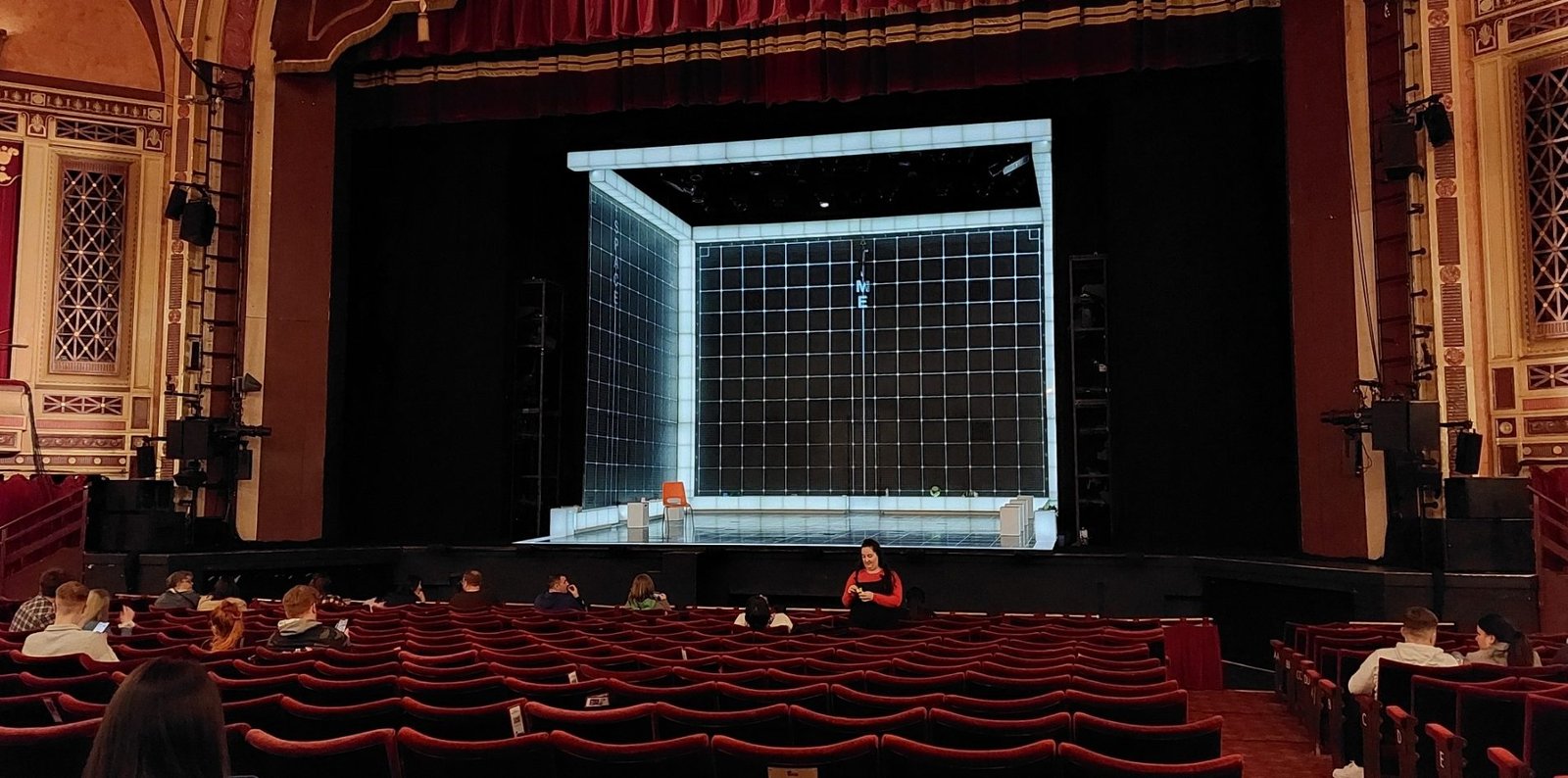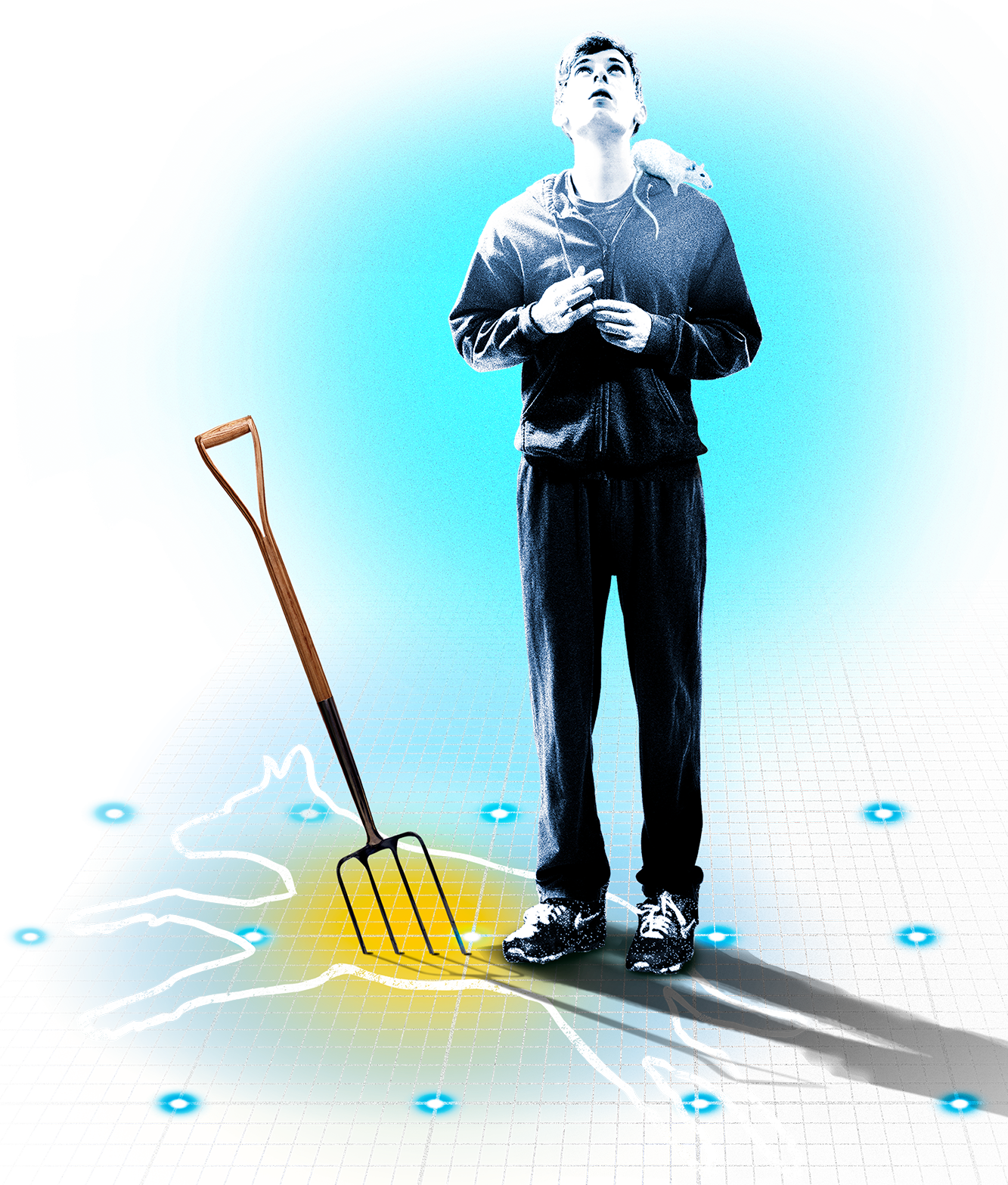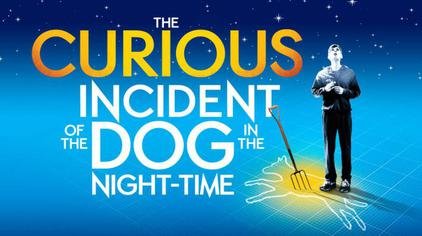Did you know that one-worded poems’ are a thing? Well they are, and if I was a poet, and I wrote a one-worded poem, I would entitled mine “Wow”, as a one-worded review of this evening’s performance of The Curious Incident of the Dog in the Night-Time. This was the first true play I have seen in many a year and I have to admit, following previous disappointments this week, there was a time today I was considering not attending. But as I was taking my aunt to the performance as my guest, I pushed myself to do so.
Getting there we chose not to use the train (which involves a long walk) or wait for a taxi (which have proved themselves completely unreliable of late), instead we made the decision early on to simply walk around and get the bus in to town. We did, got off and walked up slowly to the theatre. We arrived at an entrance which was conspicuously empty (compared to the main entrance of the theatre), and was allowed into the venue. This performance, together with many that are happening at this time, post lockdown was subject to various different policies noted via the website while booking and the tickets. But of course, most of that has now gone out of the window, and the mandatory “bag-check” is frankly laughable at best.
We paused in the lobby for 10-15 minutes before a quick trip to the toilet before the doors to the house opened. We were let into the theatre and a friendly assistant guided us directly to our seats. M22 & 23 in the Stalls. On the ground floor, around 6-7 steps down. We had end seats which was good for the old legs. Still involved a little bit of standing up to allow people into and out of the seats in the row, but they simply had to be patient while we extracted ourselves from the seats. We noted early on that there was a wide demographic to the audience. There were at least two sections full of teenages on what appeared to be school trips. Once they were seated, they were quiet and respectful. There were plenty of other age groups there too, ranging from teenages to oap’s.
The adults in the audience, I have to say at this point, I found rather disrespectful to both the actors on stage performing and to the other members of the audience. There was a constant soundtrack of bags of sweets and food opening, mobile phones going off, coughing, squeaking chairs and so on. Sure you are ‘supposed to focus on the action on stage’, but staying focused was sometimes difficult due to the evolving soundscape of disrespectful so-called ‘adult’ theatre goer’s. At one point later in the show, there was even spontaneous human interaction where a quiet moment on stage was filled with somebody saying the word ‘shit’. Lovely. What a comic, what an idiot. But you will always find that one person who does that for comedic effect. The only effect he got from me was a turn of the head and a stair down into his soul. Facebook messenger woman earned herself a stair too till somebody told her to put it on silent.
The theatre was not full unfortunately. There was a large selection of seats to our left and behind to our right. Our row was one of the few that was full. Of course being downstairs we couldn’t see how full it was in the Circle and above, but I am glad we were down below, as the view from the seats was good. Here’s a viewpoint from my seat:

(Taken from before the seats in front filled up (it wasn’t that empty, no). The stage was a unique cube shape. When we arrived, we wondered if that was the actual stage or a projection or set etc. (Spoilers) I can tell you that what you see in the picture above IS the set. The majority of the action takes place within the cube as shown. There are no other props aside from the chair, blocks and one or two more items brought on to the stage by characters as part of the play. The cube is physical, there’s no projection going on there and the lit blocks around the edges are true rgb lightblocks.
The performance itself. It starts with the cast coming on to the stage through well hidden doors in the sides and rear of the stage. They enter under darkness and sit on the light blocks as shown above. There is a loud bang like a clap of thunder and a flash of lighting and the play has begun. The opening scene has main character Christopher Boone (played by David Breeds in our performance), sobbing and visibly shaking over the corpse of a dog in a garden of one of his neighbours who is screaming ‘get away from my wellington’ (the dog) who has been brutally murdered by way of a pitchfork protruding from its abdomen. Pretty soon the police are called and an officer starts to question 15 year old Christopher Boone. From the outset it is possible through the clever use of stage and lighting design that Christopher is trying to navigate the world while facing some kind of unspoken neurodiversity. The stage is awash with noise, lights and movement depicting the panic he is feeling about the situation he is facing in front of him.

Christopher cannot rest with what has happened and takes on a Sherlock Holmes kind of investigation into the murder of Wellington, even after being told strictly by his Father Ed (played by Tom Peters) to leave the matter alone. Christopher writes down his investigation notes in the form of a book again against his Father’s wishes, and even goes so far as to show the book to his in-school helper / therapist Siobhan (played by Rebecca Root), who begins reading from the book and thus narrating the play. Later in the second act there are multiple references made to this book, breaking the 4th wall in informing Christopher that the book has been pretty successful ‘we made a play out of it’, in a clever turn of phrase. I won’t spoil the rest of the storyline much other than to say the play covers the main bones of the book (written by Mark Haddon) [and read by me years and years ago] faithfully including topics of family abuse, deep-routed family secrets, trust (and the lack of it) and fear. Of course sections are shortened and abridged to be placed upon the stage and to work in the format of a play, but I think Mark Haddon would be very pleased by the adaptation that Simon Stephens has produced, directed by Marianne Elliott.
 The thoughts and feelings of Christopher and his battle with neurodiversity are shown on the stage through extensive lighting, sound and video design with projections happening on the floor and all walls of the cube set. There is a scene that comes to mind for me where Christopher is describing to his Father Ed, his dreams of becoming an Astronaut, describing how he would move around in the zero gravity of space, inside his spacecraft on his own. Instead of making this a flown section using wires or other traditional flying tools of the theatre, the ensemble is present on stage and lift and turn Christopher producing these movements through frantic motion. You can see him jumping around as if on a planet without gravity, and later during another scene set in the chaotic space of the London Underground, Christopher even walks on the walls of the set – sideways, held up by nothing other than the ensemble cast.
The thoughts and feelings of Christopher and his battle with neurodiversity are shown on the stage through extensive lighting, sound and video design with projections happening on the floor and all walls of the cube set. There is a scene that comes to mind for me where Christopher is describing to his Father Ed, his dreams of becoming an Astronaut, describing how he would move around in the zero gravity of space, inside his spacecraft on his own. Instead of making this a flown section using wires or other traditional flying tools of the theatre, the ensemble is present on stage and lift and turn Christopher producing these movements through frantic motion. You can see him jumping around as if on a planet without gravity, and later during another scene set in the chaotic space of the London Underground, Christopher even walks on the walls of the set – sideways, held up by nothing other than the ensemble cast.
There are periods during the performance where rhythm and specific pronunciation are used to good effect. Christopher often finds himself inimating members of the cast that he is talking with, emphasising points they make in the way they make them, back to them to comedic effect. This together with movements experienced by those who find themselves identifying as neurodivergent such as shaking and rocking movements that anxiety suffers battle with. Some of Christopher’s lines are delivered so quickly that you could almost consider him to be mumbling. I didn’t find this personally, I found everything he said to be clear and easily understandable, but yes sometimes delivered extremely fast. I saw many of my own manorisms in Christopher to some extent. Breen’s performance overall however is sensational. He doesn’t over-play the part at all and I found it true to the book and believable throughout.
The rest of the cast does a great job in supporting Christopher in their own way including his Father who’s relationship with his Son becomes strained. His Mother plays her part well as she tries to understand why her Son never wrote to her or replied to any of the 42 letters she had sent him over the past two years, unknowing to her that Christopher’s Father had told him she was dead. The moral of the story is in itself a feature of the play, as Christopher states that he himself struggles sometimes to understand morals and meanings. It is a life-affirming story that achievement is possible if you are ready and brave enough to take those first steps and to try. It is in many ways a heartbreakingly heartwarming tale of modern family life.
The play ends as abruptly as it begins, with Christopher asking a question to his teacher / assistant / therapist after achieving his A-level results of “Does that mean I can do anything I want to do now?” – Of course we don’t get the answer, we get a cliffhanger. The cast comes back on stage in full ensemble and take their applause and bows once or twice and then disappear off stage. However we are not quite done, because if you were paying attention during one of the earlier scenes, while Christopher is sitting his A-level maths exam, he becomes confused by a question and his assistant talks him through how to calm down and breathe, and how to focus on one specific thing when the world is going a crazy speeds and refocus his mind. After doing that he is able to focus and able to read the question. He wants to answer it in full, and beings to do so, before again the 4th wall is broken by his assistant telling him to write it down. “The audience, they don’t need to know how you came to the answer to a math question”, “but it is my favorite answer” replies Christopher. “That’s ok, you can tell them at the end and if anyone is interested they can stick around if they want to”, Christopher agrees and goes back to finishing his exam. – The play continues like nothing happened.
After the bows and applause at the end of the play, Christopher returns to the stage and begins to explain the answer to the math question, as he promised he would do during the play. He says during the exam he had forty one minutes to answer this question, but as he had spent thirty seven minutes moaning about it he had to answer it in four minutes. So on the screen behind, a clock is placed with four minutes on it and he starts to explain how to work out his favorite equation, pythagoras theorem. This is done cleverly through music, sound, projection and a simply stunning final monologue delivered at speed all in under four minutes. A final bow and the show is over.
I’ve left parts out, which include a dramatic scene during which Christopher has to navigate a national rail journey to London, and an incident on the chaos of the London Underground (involving Christopher’s pet rat Toby). Finally a collective coo-ing of the audience when his Father, trying to rebuild his trust with his Son, buys him a Puppy (a real live puppy is brought out on the the stage) for a few minutes showing an all-together softer and different side to Christopher.
If you have a chance to catch the national tour of The Curious Incident of the Dog in the Night-Time, go and see it. This particular performance started in the National Theatre in London and is touring the UK including more dates here in Liverpool till the 26th March 2022 and continuing nationally beyond. The play runs for around two hours forty minutes with a sizeable interval between act one and two and is suitable for eleven years and upwards. If you can’t get to see it, borrow or buy the book, it is a worthy read.
Finally I want to mention the cast in full and the creative team behind this performance on tour:
CAST
David Breeds and Connor Curren as Christopher (alternating weeks)
Sophie Stone and Kate Kordel as Judy (alternating weeks)
Jacob Coleman as Christopher understudy
Kofi De-Graft-Jordan as Mr Thompson
Ashley Gerlach as Mr Shears
Joanne Henry as Mrs Alexander
Siu-See Hung as Punk Girl
David Monteith as Reverend Peters
Tom Peters as Ed
Rebecca Root as Siobhan
Hannah Sinclair Robinson as Mrs Shears
ENSEMBLE
Marc Benga, Sibylla Meienberg, Joe Rawlinson-Hunt and Rebecca Wilson
CREATIVE
Directed by Marianne Elliott
Designed by Bunny Christie
Lighting Designed by Paule Constable
Video Designed by Finn Ross
Movement Direction by Scott Graham & Steven Hoggett for Frantic Assembly
Sound Designed by Ian Dickinson for Autograph
Music by Adrian Sutton
You can find more information about The Curious Incident of the Dog in the Night-Time online via the tour website here: www.curiousonstage.com.

